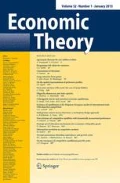Abstract
This paper characterizes unit-consistent poverty indices. The unit consistency axiom requires that poverty rankings (not poverty indices) remain unaffected when all incomes and the poverty lines are expressed in different measuring units. We consider two general frameworks of poverty measurement: the semi-individualistic framework that includes all decomposable indices and all rank-based indices; and the Dalton–Hagenaars framework that contains a subset of decomposable indices. Within the semi-individualistic framework, classes of unit-consistent poverty indices can be characterized for different value judgements about poverty measurement. Within the Dalton-Hagenaars framework, unit-consistent poverty indices are completely characterized without invoking any value judgement a priori.
Similar content being viewed by others
References
Aczél J. (1966). Lectures on functional equations and their applications. Academic Press, New York
Amiel Y., Cowell F. (1992). Measurement of income inequality: experimental test by questionnaire. J Public Econ 47:3–26
Amiel Y., Cowell F. (1997). Thinking about inequality. Cambridge University Press, Cambridge
Atkinson A. (1992). Measuring poverty and difference in family composition. Economica 59:1–16
Ballano C., Ruiz-Castillo J. (1993). Searching by questionnaire for the meaning of income inequality. Revista Española de Economia 10: 233–259
Bossert W., Pfingsten A. (1990). Intermediate inequality: concepts, indices, and welfare implications. Mathematical Social Sciences 19:117–134
Bourguignon F. (1979). Decomposable income inequality measures. Econometrica 47:901–920
Chakravarty S. (1983). A new index of poverty. Math Soc Sci 6: 307–313
Clark S., Hemming R., Ulph D. (1981). On indices for the measurement of poverty. Econ J 91:515–526
Cowell F. (1980). On the structure of additive inequality measures. Rev Econ Stud 47:521–531
Dalton H. (1920). The measurement of the inequality of incomes. Econ J 30:348–361
Foster J., Greer J., Thorbecke E. (1984). A class of decomposable poverty measures. Econometrica 52:761–766
Foster J., Jin Y. (1998). Poverty orderings for the Dalton utility-gap measures. In: Jenkins S., Kapteyn A., van Praag B. (eds) The distribution of welfare and household production: international perspectives. Cambridge University Press, London
Foster J., Shorrocks A. (1991). Subgroup consistent poverty indices. Econometrica 59: 687–709
Hagenaars A. (1987). A class of poverty indices. Int Econ Rev 28:583–607
Harrison E., Seidl C. (1994). Perceptional inequality and preferential judgements: an empirical examination of distributional judgements. Public Choice 79:61–81
Jenkins S., Lambert P. (1993). Ranking income distributions when needs differ. Rev Income Wealth 39:337–356
Jenkins S., Lambert P. (1997). Three “I”s of poverty curves, with an analysis of UK poverty trends. Oxford Econ Papers 49:317–327
Jenkins S., Lambert P. (1998). Three “I”s of poverty curves and poverty dominance: TIPs for poverty analysis. In: Slottje D.J. (eds) Research on economic inequality 8. JAI Press, Stamford, Conn. London
Kolm S. (1976). Unequal inequalities II. J Econ Theory 13:82–111
Kocklauner G. (2003). A centrist poverty index. FH Kiel, mimeo
Krtscha M. (1994). A new compromise measure of inequality. In: Eichhorn W. (eds) Models and measurement of welfare and inequality. Springer, Berlin Heidelberg New York
Lambert P. (2001). The distribution and redistribution of income, 3rd Edn. Manchester University Press, Manchester New York
Lambert P., Millimet D., Slottje D. (2003). Changing poverty or changing poverty aversion?. Southern Methodist University, Dallas, mimeo
del Rio C., Ruiz-Castillo J. (2000). Intermediate inequality and welfare. Soc Choice Welf 17:223–239
Seidl C., Pfingsten A. (1997). Ray invariant inequality measures. In: Zandvakili S. (eds) Research on economic inequality 7. JAI Press, Greenwich, Conn. and London
Sen A. (1976). Poverty: an ordinal approach to measurement. Econometrica 44:219–231
Shorrocks A. (1980). The class of additively decomposable inequality measures. Econometrica 48:613–625
Thon D. (1979). On measuring poverty. Rev Income Wealth 25:429–440
Watts H. (1968). An economic definition of poverty. In: Moynihan D.P. (eds) On understanding poverty. Basic Books, New York
Zheng B. (1993). An axiomatic characterization of the Watts poverty measure. Econ Lett 42:81–86
Zheng B. (1997). Aggregate poverty measures. J Econ Surv 11:123–162
Zheng B. (2000a). Poverty orderings. J Econ Surv 14:427–466
Zheng B. (2000b). Minimum distribution-sensitivity, poverty aversion, and poverty orderings. Journal of Economic Theory 95:116–137
Zheng B.: Unit-consistency and inequality orderings, paper presented at the Sixth International Meeting of the Society for Social Choice and Welfare, Caltech, Pasadena, CA (2002)
Zheng, B.: Unit-consistent decomposable inequality measures. Economica (forthcoming, 2005)
Zoli C. (1999). A generalized version of the inequality equivalence criterion: a surplus sharing characterization, complete and partial orderings. In: De Swart H. (eds) Logic, game theory and social choice. Tilburg University Press, Tilburg
Author information
Authors and Affiliations
Corresponding author
Additional information
I thank Peter Lambert, Mike Hoy, Thesia Garner and an anonymous referee for their very helpful comments and suggestions.
Rights and permissions
About this article
Cite this article
Zheng, B. Unit-Consistent Poverty Indices. Economic Theory 31, 113–142 (2007). https://doi.org/10.1007/s00199-006-0085-7
Received:
Accepted:
Published:
Issue Date:
DOI: https://doi.org/10.1007/s00199-006-0085-7
Keywords
- Semi-individualistic poverty indices
- Dalton-Hagenaars poverty indices
- Unit consistency
- Scale invariance
- Decomposability




